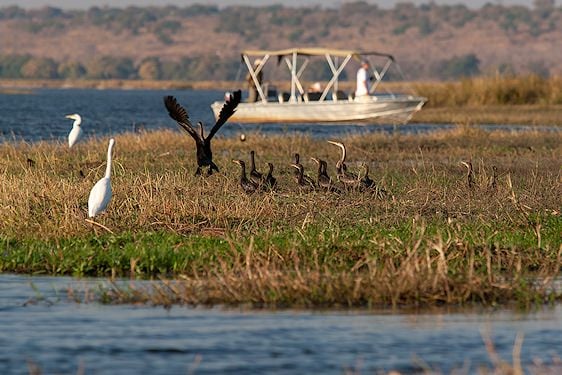- Home
- >
- African Travel
- >
- South Africa
- >
- National Parks
- >
- Kruger National Park
- >
- Mammals
- >
- Waterbuck
Description
Waterbuck are large, robust antelope with gray-brown coats and a distinctive white ring on the rump. Males carry long, lyre-shaped, ridged horns; females are hornless. A broad muzzle, shaggy neck hair, and oily coat—thought to improve waterproofing—aid life near water. The species is readily identified along river margins, floodplains, and dam edges.

The common waterbuck occurs from northern South Africa through Mozambique, Botswana, Zimbabwe, and Zambia, with strongholds wherever permanent water and good grazing coincide. In Kruger National Park, look for herds around major rivers and productive floodplains, where mixed grasses support regular feeding and open views provide early detection of predator.

Status
Waterbuck are currently assessed as Least Concern with an estimated total population near 200,000 across sub-Saharan Africa. Trends vary regionally: numbers are generally stable or increasing where habitat and water are protected, and lower where overhunting and settlement expansion degrade river corridors. A large share occurs in protected areas and on private land under wildlife management.

Habitat
Strongly water-dependent grazers, waterbuck concentrate near perennial rivers, dams, and waterholes bordered by open woodland or floodplain grassland. In Kruger, they favor river systems and artificial water points with adjacent grazing and scattered cover. They avoid arid, treeless expanses far from water and typically remain within a short commute of reliable drinking sites.

Social Organization
Herds usually comprise related females and their young within the range of a territorial male. Bachelor groups form among non-territorial males. Territory size reflects habitat productivity and water distribution; studies report typical ranges of 10–40 ha (0.1–0.4 km²). In higher-quality areas, turnover among males can be frequent as condition and grass height shift through the seasons.
Finest Safari Areas in Africa for Encountering Waterbuck
We recommend the following National Parks and Private Reserves for the best chances of spotting waterbuck on safari game drives and bush walks.

Social Behavior
Daily routines center on grazing, ruminating, and accessing water. Dominant males patrol boundaries, advertise with scent and posture, and engage in horn wrestling when rivals persist. Females maintain cohesion with soft calls; mothers groom and attend calves, which hide briefly after birth before joining the herd and learning travel routes to favored water and grazing.

Reproduction
Courtship includes foreleg-lifting, parallel walking, and scent exchange. Estrous females may mate with the territorial male and, less often, a nearby challenger; males can service multiple females while they are in heat. Females mature around three years; males acquire territories later. Gestation is about eight to eight and a half months, with births peaking where rains boost grass.

Anti-Predator Behavior
On detecting predator, herds snort alarms and bunch before moving to open ground or water. Males sometimes confront smaller attacker with lowered head and horn displays, but flight is typical against large carnivore. Despite a strong odor, waterbuck are regularly taken by lion, leopard, hyena, and wild dog where ranges overlap and ambush cover exists along river margins.












